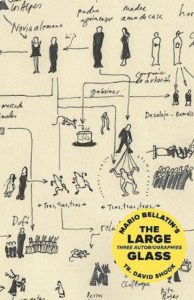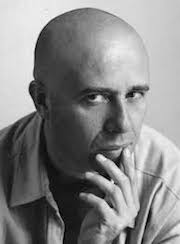
The Large Glass wholly departs from the expectations of its genre: the autobiography. Written as three distinct works, published in unison, Mario Bellatin’s book takes the reader on an extended, bizarre romp full of snarky and defiant critiques of autobiography as a form. Bellatin embraces chaos and poetry in a style intended to fluster and confound. There is no explanation or rationalization, just endless momentum.
The reader can never quite be sure whether the events are ‘real’ or ‘imagined,’ a distinction Bellatin actively breaks down throughout the text. He opts instead for ‘written.’ As a reader, it is difficult to abandon credibility in a text, to say to oneself that it doesn’t matter whether the events are true, concrete, or believable. Bellatin seeks to prove a point: that no autobiography can be factual and true. He latches on to the insecure fluidity between fact and fiction, between dream and reality. In refusing both the real and the imagined, Bellatin forces the reader to reimagine the polar opposition of fiction and nonfiction.
The Large Glass offers enormous frustration and (eventually) gratification for readers. There is little narrative continuity and no linear progression through time or space. The book is rich in imagery and feeling, but thin on plot. The excitement is in the language, whose electricity is magnified and underscored by David Shook’s translation. The narrator is multiple people wound up into a single “I” with shared memories and allusions, some of which reference the details of Bellatin’s life.
The first autobiography, My Skin, Luminous, is a 363-item list describing the unusual youth of a boy whose mother displayed him—more specifically, his testicles—“on the outskirts of the tomb of Sufi Saint Nizamudin.” Bellatin encapsulates the uncomfortable, disjointed adolescent years, when his suffocating family is unavoidable, as he first encounters his own sexuality. He transfers the deception and manipulation of these years into seemingly contradictory sentences.
206 — After the departure of my father, I never saw anything sensible said to my mother. […]
223 — Initially the house was rented to us for a couple years; I remember it as a wonderful moment.
In item 206, he aligns two distinct senses: sight and hearing. In item 223, a couple of years collapse into a single moment, a spark of the past whose actual duration is insignificant. Yet how savory both sentences are. This attentive use of language recurs in each of the three autobiographies.
The second autobiography, The Sheikha’s True Illness, is written as a series of long paragraphs divided by line breaks. It reads like a dream journal, an amalgamation of related but distinct wanderings and conversations. Where My Skin, Luminous is a punctual and precise account of youth, The Sheikha’s True Illness is a descriptive and fluid take on Bellatin’s religion. He converted to Sufism some twenty-odd years ago. His conversion was an experience “not mystical, but rather literary… there was an absolute change in regards to the freedom of my work. Before I met the Sufi group… my work was in some way framed within how traditionally literary artistic things should be. Once I changed—I entered Sufism—it was like I broke the limits.”

In this autobiography, Bellatin blurs the boundaries between his texts and his life: they permeate each other to the point of becoming indistinguishable. He sits in the living rooms of the characters he has written, who “despite appearing in a bad light, are pleased with the work.” My Skin, Luminous becomes a poetic autobiographical play, as Bellatin toys with line and meter, setting the whole story in a numerical flow that has no linear relationship to the passage of time. The Sheikha’s Illness takes a subtler approach rooted in the (somewhat boring) everyday happenings in his religious community. Bellatin peppers the steady and meditative flow of ordinary descriptions with departures into the surreal, like the encounters with his own characters. The strange stillness carries something of Juan Rulfo’s Pedro Páramo.
In the last autobiography, A Character Modern in Appearance, Bellatin sets up a droll and absurd situation. The narrator (Bellatin, transformed) is “the youngest daughter of the family”, told she looks “like a little doll. ” He positions himself as the female narrator of an autobiography written by a man who—honestly—admits to lying. First, “I think I’m something of a liar.” Later on, “One of the main characteristics of my personality is lying all the time.” The narrator (a writer herself) equally struggles with language and communication. She admits, “So far, as I said, I have not fully mastered Castilian. But worst of all is that before this awkward learning there was no mother tongue for me. I am unable to communicate, just like that. … Nonetheless, since I turned forty years old I have written books.”
Between these announcements come lengthy descriptions whose prose is vivid and convincing: family homes demolished to make way for highways; grandparents who fed off of living pigs because electricity was too scarce and too expensive to butcher a whole animal and keep the meat fresh. Despite the professed unreliability, the narrator’s stories are visceral and addictive. Their desperate and deliberate emptiness is reminiscent of the scenes of northern Mexico found in Roberto Bolaño’s 2666:
[The house] was, as we know, located right in the middle of the path of the highway that would link the north and the south of the city. Nobody knows it, but my father was one of the men who made up the crew of surveyors who had to map the motorway’s route. Duty first, he said on more than one occasion. It wouldn’t have cost him anything to make his measurements a little crooked, thereby affecting more houses on the other side. But those houses belong to families that did have the right to a full life. So he made the most direct line between north and south, resulting in our living room’s being compromised.
It can be difficult to get past the point Bellatin tries to prove throughout this book—that “autobiographies or traditional biographies are always false.” The frustration at his game mounts throughout the second and third sections. He introduces new cards and replays the same ones multiple times, with little promise of resolution, pressing his audience to abandon its desire for narrative cohesion, to accept his outlandish and hysterical means of storytelling.
The frustration dissipates in the last few pages of the book, where Bellatin takes a few hundred words to explain himself. His perpetual reinvention is “not to create new institutions to ascribe myself to. Simply to allow the text to manifest itself in all its possibilities.” These autobiographies are much more about texts than they are about Bellatin’s life. He writes, “This journey seems only to have served to some years later convert me simply into a contemporary writer, who almost without noticing offered up his life… his true desire wound up being the word. And to share it also with two or three friends whose choice was similar: that of writing just to write.” As a contemporary writer, he insists, “Knowing is entirely irrelevant.” The truth—be it of nation, religion, gender, or language—doesn’t bring him any pleasure as a writer or a person.
Though an unusual and often stupefying writer, Bellatin remains open and honest about his intentions to toy with form. The strictures of literary tradition depend too much upon narrow visions and sectioned worlds. The Large Glass posits a kind of radical openness of self, relying on the plausible rather than the definite. Its author revels in the potential of the written word to distort, amuse, and, ultimately, to free. His dedication to writing as a playful and exploratory art form is, he writes, “perhaps why, despite the widely scattered life I’ve led, I am now happy. Without the baggage of emotions, family, nation, or identity.”




